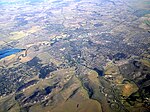Electoral district of North Bourke

The Electoral district of North Bourke was one of the original sixteen electoral districts of the old unicameral Victorian Legislative Council of 1851 to 1856. Victoria being a colony in Australia at the time. The district's area was defined as: "Bounded on the north by the great dividing range from the source of the River Plenty to the source of the Werribee River on the west by the Werribee River to Port Phillip Bay on the south by Port Phillip Bay to the mouth of the Yarra Yarra River and by that river to the confluence of the River Plenty and on the east by the River Plenty to its head in the great dividing range."From 1856 onwards, the Victorian parliament consisted of two houses, the Victorian Legislative Council (upper house, consisting of Provinces) and the Victorian Legislative Assembly (lower house).
Excerpt from the Wikipedia article Electoral district of North Bourke (License: CC BY-SA 3.0, Authors, Images).Electoral district of North Bourke
Francis Boulevard, Melbourne
Geographical coordinates (GPS) Address Nearby Places Show on map
Geographical coordinates (GPS)
| Latitude | Longitude |
|---|---|
| N -37.583333333333 ° | E 144.75 ° |
Address
Francis Boulevard
Francis Boulevard
3429 Melbourne
Victoria, Australia
Open on Google Maps






